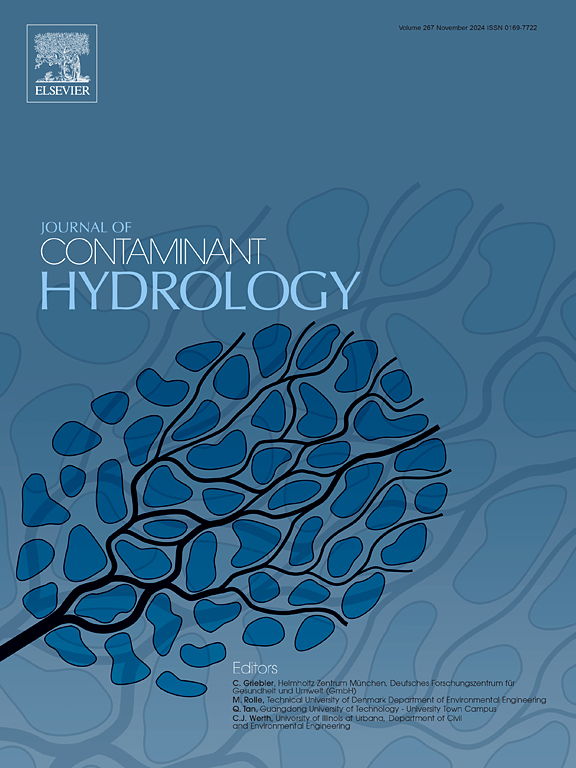Spatial and temporal variation in the natural source zone depletion rates of two types of LNAPL sources
IF 4.4
3区 环境科学与生态学
Q2 ENVIRONMENTAL SCIENCES
引用次数: 0
Abstract
Accurate measurement of natural source zone depletion (NSZD) rates is a crucial but challenging task at a large site since NSZD rates usually have large temporal and spatial variation. Few studies focus on the spatial and temporal variability of NSZD rates of different types of light non-aqueous phase liquid (LNAPL). This study has explored the spatial and temporal variability of NSZD rates at one site with two chemically distinct LNAPL bodies (aliphatic-rich naphtha for Source Zone #1 vs aromatic-rich pyrolysis gasoline for Source Zone #2). Higher temperatures result in higher NSZD rates, leading to the highest NSZD rates in summer and the lowest in winter in both Source Zone #1 and #2. Although the LNAPL in Source Zone #1 and #2 have completely different composition, the difference in the area-weighted average NSZD rates between Source Zone #1 and #2 was not statistically significant. Natural soil respiration (NSR) is the dominant source of CO2 emitted at the land surface throughout all seasons at this site. This suggests that during the growing season (summer), both high mean value and high standard errors of NSR rates compromise the NSZD quantification results based only on simple background correction (using the mean value). This result highlights the significant spatial and temporal variation of NSZD rates in large site and the challenges of using background correction to estimate NSZD rates. It is necessary to consider the importance of data quality to the subsequent data management process.

两种LNAPL源自然源带耗竭率的时空变化
由于自然源带耗竭率具有较大的时空变化,因此在大型站点精确测量自然源带耗竭率是一项至关重要但具有挑战性的任务。不同类型轻非水相液体(LNAPL)的NSZD速率的时空变异性研究较少。本研究探讨了两个化学性质不同的LNAPL体(源区1为富脂肪石脑油,源区2为富芳烃热解汽油)在同一地点NSZD速率的时空变化。温度越高,NSZD率越高,导致源1区和源2区夏季NSZD率最高,冬季最低。虽然源1区和源2区LNAPL的组成完全不同,但源1区和源2区面积加权平均NSZD率差异无统计学意义。自然土壤呼吸(NSR)是该站点所有季节地表二氧化碳排放的主要来源。这表明,在生长季节(夏季),NSR率的高平均值和高标准误差都会影响仅基于简单背景校正(使用平均值)的NSZD量化结果。这一结果凸显了大场地NSZD率的显著时空变化,以及利用背景校正估算NSZD率的挑战。有必要考虑数据质量对后续数据管理过程的重要性。
本文章由计算机程序翻译,如有差异,请以英文原文为准。
求助全文
约1分钟内获得全文
求助全文
来源期刊

Journal of contaminant hydrology
环境科学-地球科学综合
CiteScore
6.80
自引率
2.80%
发文量
129
审稿时长
68 days
期刊介绍:
The Journal of Contaminant Hydrology is an international journal publishing scientific articles pertaining to the contamination of subsurface water resources. Emphasis is placed on investigations of the physical, chemical, and biological processes influencing the behavior and fate of organic and inorganic contaminants in the unsaturated (vadose) and saturated (groundwater) zones, as well as at groundwater-surface water interfaces. The ecological impacts of contaminants transported both from and to aquifers are of interest. Articles on contamination of surface water only, without a link to groundwater, are out of the scope. Broad latitude is allowed in identifying contaminants of interest, and include legacy and emerging pollutants, nutrients, nanoparticles, pathogenic microorganisms (e.g., bacteria, viruses, protozoa), microplastics, and various constituents associated with energy production (e.g., methane, carbon dioxide, hydrogen sulfide).
The journal''s scope embraces a wide range of topics including: experimental investigations of contaminant sorption, diffusion, transformation, volatilization and transport in the surface and subsurface; characterization of soil and aquifer properties only as they influence contaminant behavior; development and testing of mathematical models of contaminant behaviour; innovative techniques for restoration of contaminated sites; development of new tools or techniques for monitoring the extent of soil and groundwater contamination; transformation of contaminants in the hyporheic zone; effects of contaminants traversing the hyporheic zone on surface water and groundwater ecosystems; subsurface carbon sequestration and/or turnover; and migration of fluids associated with energy production into groundwater.
 求助内容:
求助内容: 应助结果提醒方式:
应助结果提醒方式:


